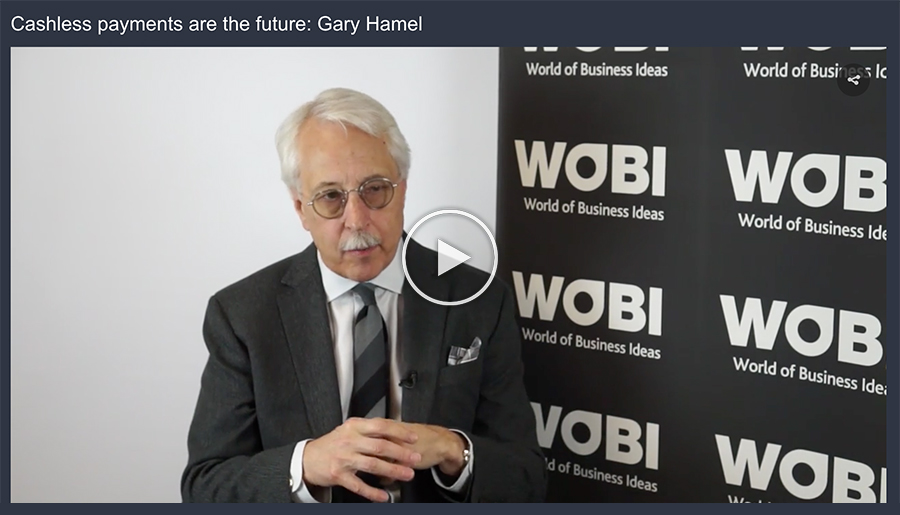Cashless payments are the future: Gary Hamel
World leading business strategist, Gary Hamel, says mobile payments are the future. He says banks “will be an app” and businesses that don’t evolve with “these bleeding edge technologies…will get outmaneuvered”. Garry has helped many of the top 100 companies like Royal Dutch Shell (AMS:RDSA), Adidas (ETR:ADS), Whirlpool (NYSE:WHR) become what they are today. Jessica Amir has the full interview from the World Business Forum.
Transcript
Hi I’m Jessica Amir for the Finance News Network at the 2019 World Business Forum. Earlier we caught up with Gary Hamel who’s transformed the likes of Shell (NYSE:RDS), Whirlpool (NYSE:WHR) and Adidas (ETR:ADS) into the billion dollar empires they are today. Creating billions of dollars in shareholder value. And here’s what Gary had to say earlier.
Jessica Amir: PwC and Visa say mobile and cashless payments will be the future. What are your thoughts?
Gary Hamel: Not will be, it is the future. Most of the Chinese economy now, Alipay (NASDAQ:BIDU) and Tencent Pay, dominate mobile payments there. West has been a little bit behind on that but it’s already the future. Not will be, it is the future.
Maybe it’s too late for some of these institutions, I don’t know. But I would give them two pieces of advice. First, start with a proposition, start with the assumption that your industry will be an app. The whole industry is going to be an app. Now how you deal with that and get there, you can figure out. But if you don’t believe that in your gut, then you’re going to get outmaneuvered by whoever these things are, they’re different in different countries. The biggest digital bank in Europe right now is called N26, it’s started by a couple people from Austria and based in Berlin. Austria, then based in Berlin. They’ve raised already a half billion dollars of venture capital. They already have a banking license in 24 countries, they have two million customers. It’s unbelievable what they’re doing. So you have to be willing, not to say “That might happen, whatever.” You’ve got to say “A big part, not a big part, is going to be an app. What is that going to mean for us?”
The other part though that should give you a little bit of hope is, people still want relationships. And there’s still going to be a place, I think, for face-to-face, for having a branch network, for being able to deliver that service. I mean there’s nothing that Apple (NASDAQ:AAPL) sells that I can’t buy somewhere else, and yet the Apple store is one of the most profitable retailers in the world. Right? So people want. But if you go into the Apple store today, it is less about the product than it’s about fixing your iPhone or your device, it’s the Genius Bar, it’s about taking an Apple Today course on how do you use your phone for photography. So they’re going to have to reimagine what that is.
What’s interesting to me the most, the most consistently profitable bank in the world is Svenska Handelsbanken (STO:SHB-A) based in Stockholm. They operate 800 branches across Northern Europe. It is the most radically decentralised bank that I’ve ever come across. Every branch is operated as completely its own PNL. People in the branch set prices, if you can imagine. Prices on loans and deposit are set by people in the branch. They decide on who to hire, what size staff they use. They control most of the marketing budget. If you are a customer of the bank, you have the phone number for the branch manager in your town, in your village close to your home. You are given a personal represent … And this is not high end, this is not luxury banking. This is for everybody. You’re given also a local representative that you call.
What is it like now if you deal with the big bank in Australia? I’m willing to bet you call some call centre, they know nothing about you except data they pull up on a screen. It is completely impersonal. When you call them they’re going to spend the first three minutes of the call trying to convince you to go to their website as if you’re the last person in the world that knows that businesses have websites, right? They’re going to tell you that your call is important to them when clearly it wasn’t or you’d already be talk … I mean it’s an awful experience.
And so here you have this company that is overinvested in their branches and incredible personal service, they are more profitable on every measure than any of their European peers for the last 40-some-odd years, they have loyalty that is off the charts, and yet in most banks we’ve made everything so centralised, loan approval, customer care, that it feels now like a commodity. It does not feel personal, it does not feel like a relationship. And you’ve got to change that. And so … those models are going to coexist. Right? It’s going to become incredibly efficient on an app but there are going to be times when I want someone who knows my name, knows my family, know what’s going on in my personal life, is willing to sit down with me, and is not there to cross sell me one of their other products, is there to treat me as a real human being.
Jessica Amir: Amid the digital revolution, how can organisations get a leading edge?
Gary Hamel: If you don’t think about this in the right way you will always be behind. You’re always going to be like five years later you’re going to say, “Oh yeah, mobile payments is going to be a big thing.” No kidding. The way you get in front of that, I think, is the following. You have to recognise that different source of technology are going to reinvent every single industry on the planet. It’s happened in publishing, it’s happened in music, it’s now happening in finance, it’s happening in education, it’s happening in the taxi business, it’s happening in hospitality, it’s going to happen. So you have to step back and say, how are we transforming the customer experience? To do that you have to have real, deep empathy on what it feels like to be a customer.
Let me give you, not a banking example, I’ll give an example. I’ll get in trouble for saying this. So I flew in from San Francisco yesterday on Qantas (ASX:QAN) flight from San Francisco to Sydney. So they have business class and they have no first class, they have business class and economy class on this plane. So I’m 14, 15 hours in a business class seat that didn’t recline. It had a mechanical fault. So sitting for 15 hours when you were hoping to have a night of sleep bolt upright is not so good. The crew were quite sympathetic, they were nice people, they said, “Gary we can give you ten thousand frequent flyer miles for this. Well I have about two million frequent flyer miles. Ten thousand, and by the way the value of that is at a hundred dollars. And this is maybe a four, five thousand or six thousand dollar ticket and they’re saying how to. No. It’s not their fault.
They work at an organisation where they have no freedom to do the right thing for the customer. So that’s all they could do. If I want to call Qantas, which I tried to do last night, they informed me that it was one hour and thirty minutes of wait time before I could talk to a human being. Now … and only in banking and airlines of any industry do I know where this happens. You have a customer who’s worth thousands and thousands of dollars to you every year and you build a moat between them and any kind of responsiveness and care. And so I think every industry, as we speak, is being reinvented from the customer backwards. You are either in front of that, or you’re behind that.
You are either, as senior leaders, you are either out there in the branches, you are in the call centers, you’re taking the calls, you’re hearing the tone of voice, you’re understanding where the frustrations come from, or you’re not. Or you’re oblivious to it. Or you’re doing kind of the British penny wise, pound foolish thing, you’re stripping stuff out of customer care, out of cost, and you have no sense of how aggravated and frustrated it’s making customers.
So on one hand, you have to be deeply engaged in the customer’s life, in their world, to understand the opportunities to re-engineer that experience. Because most of innovation is simply emotional engineering. How do I take the frustration, anxiety out? How do I build delight and happiness in? The other thing you have to do is as you think about all these digital technologies, you have to think about what is the functionality each one delivers? There’s a technology that lets me connect people to community. There’s one that allows me to deliver expertise. There’s one that allows me to take time out of a transaction. There’s one that allows me to predict what move I’m going to do next.
You have to look at these technologies as a whole portfolio of new functionality and over here a whole portfolio of frustrations. And then you say, “Where do we put these things together?” But if you don’t have, as a leader in financial services, if I think of the top hundred people in a bank or insurance company, if I do not have personally in my heart, in my soul, that understanding of what it’s like for a customer and if I don’t have in my brain that understanding of exactly where are these bleeding edge technologies and what are they doing, there’s no hope. You will get outmaneuvered and you will get disrupted every single time.
Jessica Amir: After helping to transform some of the top 100 global companies, what are the most notable?
Gary Hamel: Back in the mid-1990s we were working with the largest part of Shell, their exploration and production division. And they had a wonderful chap there who led their R&D and he said, “It’s crazy I have a few hundred million dollars a year to spend on R&D but we aren’t getting any ideas from the front of our organisation.” So with those wonderful folks at Shell we built what I think was the world’s first kind of idea market for any company called Shell Game Changer. It still exists, it’s created billions of dollars of breakthroughs and market value. But it was a very simple idea at the time, that anybody internally, and now it’s externally as well, if you have any idea that you think might be a game changer, you share that not with your boss, you go to a jury of peers, other people they look at it. If they think the idea makes sense, you get a small allocation of money and 30 days of time to go start building an experiment. Try it out.
But the thought behind that was that we had to democratise innovation. Good ideas can start anywhere, we could already see that happening in Silicon Valley. Most companies had not created that kind of idea democracy. Average employee, if you had an idea, you didn’t know how to go get funding. You didn’t know how to get started. And so often if an idea did not match the prejudices or the interests of your boss, it died there which was kind of crazy. So we built that, I think we wrote a Harvard Business Review article about it called Bringing Silicon Valley Inside. It still exists.
We worked some years ago for Whirlpool, one of the largest appliance makers in the world. And there again, we were asking how do you turn every single employee into an innovator? So again with some amazing people at Whirlpool, we trained 30 thousand people to be business innovators, we created an internal portal where they could share their best ideas, we made innovation the single largest component of long-term executive compensation, we set aside a big portion of their capital budget every year to fund projects that met a very aggressive test of being innovative, and out of that came explosion of growth, entire new businesses. You can go back and look at their performance, but by unleashing the creative capacity of people who had never before been given permission to think in that way.
With Adidas in North America, the sportswear company or Adidas, depending on where you are in the world. There we involved three thousand people and we gave them the question of, if we have to reinvent the company to be more inventive, more creative, what do we need to change? And so they talked about how we need to change training and compensation and leadership and all of these things. They generated more than 800 culture hacks of things we would change in our internal management systems. By turning all of those people on to that idea.
Right now in one of the world’s largest tech companies, I can’t tell you who, but we have 70 thousand people on our platform that we build and they’re working there to imagine the future of their business. Recognising today, as was true when we started with Shell all those years ago, that the creative impulse exists in every human being. All of us are seeing new things every day and we just have to open the creative process up to people across the organisation.
You are either, as senior leaders, you are either out there in the branches, you are in the call centers, you’re taking the calls, you’re hearing the tone of voice, you’re understanding where the frustrations come from, or you’re not. Or you’re oblivious to it. Or you’re doing kind of the British penny wise, pound foolish thing, you’re stripping stuff out of customer care, out of cost, and you have no sense of how aggravated and frustrated it’s making customers.
So, for many years that’s been my passion of how do you build organisations that are as capable as the people inside of them. And how do you get bureaucracy out of the way to do that. And of course the amazing power there is today technology gives everybody a share of voice. It allows you to do peer review, it allows you to get funding. You look at the impact that crowd funding has had and how easy today to get a project up on Kickstarter. Several hundred thousand have now been successfully funded there. Most companies have no internal equivalent to that.
Ends
Published: 6 June 2019
By Jessica Amir


